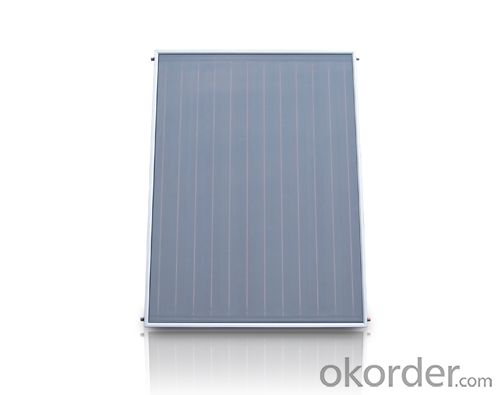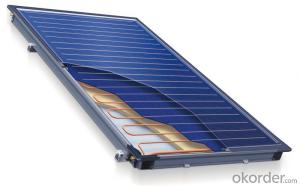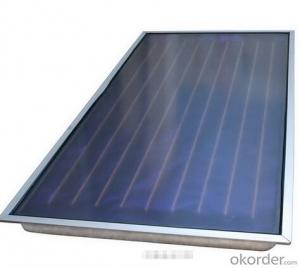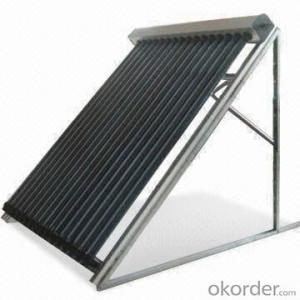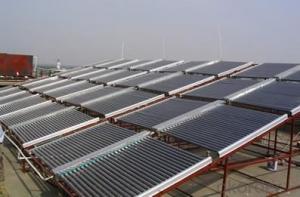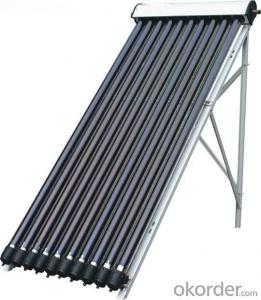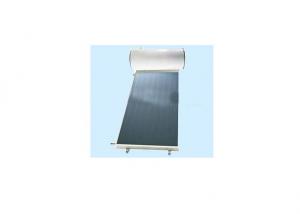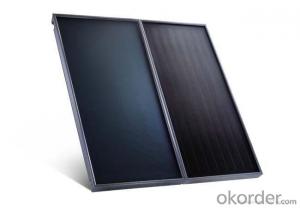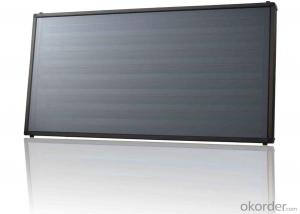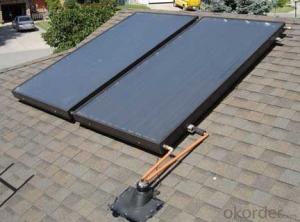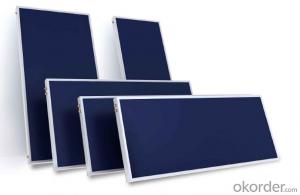Aurora Solar Collectors Hot Solar Evacuated Tube with Heat Pipe Solar Thermal Collector, Model No:FP-GV2.05-01-A
- Loading Port:
- Shanghai
- Payment Terms:
- TT OR LC
- Min Order Qty:
- 500 pc
- Supply Capability:
- 10000 pc/month
OKorder Service Pledge
OKorder Financial Service
You Might Also Like
HOT Solar EVACUATED TUBE WITH HEAT PIPE SOLAR
THERMAL COLLECTOR
Model No:FP-GV2.05-01-A ( 2015*1015*76mm)
Solar Collector Characteristics:
♦Germany imported blue titanium selectve coating,the most efficient absorber in the world
♦ Whole plate laser welding,to minimize the damage to absorption layer and copper tube
♦ 25 years lifespan
♦ Advanced processing technology and equipment,to guarantee products in high quality
Quality Assurance--Solar Collector Test
Internal pressure for absorber
* High temperature resistance
* Exposure test
* External thermal shock
* Internal thermal shock
* Rain penetration
* Mechanical load test
* Thermal performance
* Freeze resistance test
* Ice ball impact test
In-process
-Laser welder between absorber and copper tubing
-Process test with digital pressure meter at 1.2Mpa 5 minutes
-Automatic S type bending machine
-Automatic frame cutter
-Automatic frame assembly machine
-Automatic copper drilling machine
-Automatic plate leveling machine
Specifications:
Dimension L×W × H(mm):2015*1015*76mm
Gross Area(m²):2.05 m²
Absorber Area (m²): 1.82 m²
Number of covers:1
Cover material:Low iron tempered glass
Cover Thickness(mm):3.2mm
Cover Transmittance:>92%
Weight:41.5 Kg
Absorber:
Material:Aluminium board
Surface Treatment:Sputtering(Germany imported Blue titanium coating)
Absorptivity:95±2%
Emissivity: 5±2%
Construction Type:Grid type
Header Material:Copper TP2/CA1220
Header tube Size:Ø22mm x (thickness) 0.8 mm
Riser tuber size: Ø8mm x (thickness) 0.75mm
Working pressure: 0.75MPa
Test pressure: 1.2MPa, keeps 30 minutes
Whole Collector:
Maximum power, G = 1,000W/m² per collector: 1.352 kW
Thermal efficiency: 0.788
Heat loss coefficient (a1): 3.411 W/m².K
Heat loss coefficient (a2): 0.024 W/m².K
Maximum stagnation temperature for ambient conditions of 1,000W/m² and 30°C: 188.4°C
Thermal Insulation:
Insulation material: fiberglass
Insulation thickness: 35 ± 5mm
Insulation Density: 48 kg/cube
- Q: Can solar collectors be installed vertically?
- Yes, solar collectors can be installed vertically.
- Q: Can solar collectors be used for generating electricity at night?
- No, solar collectors cannot generate electricity at night as they rely on sunlight to convert it into electrical energy.
- Q: Can solar collectors be used in military operations?
- Yes, solar collectors can be used in military operations. They have the potential to provide renewable and reliable energy sources in remote locations, reducing dependency on traditional fuel supply lines. Solar collectors can power various military equipment, including communication systems, surveillance equipment, and even field hospitals. They offer a sustainable and cost-effective solution for the military to operate efficiently and reduce its environmental impact.
- Q: What is the classification of solar collectors?
- According to the collector heat transfer type: liquid collector, air collector. According to whether the solar radiation into the lighting port to change the direction of points: condenser type collector, non-concentrating type collector.
- Q: Can solar collectors be used for heating nursing homes?
- Yes, solar collectors can be used for heating nursing homes. Solar thermal systems can provide hot water and space heating for nursing homes by harnessing the sun's energy and converting it into heat. This can help reduce energy costs and lower carbon emissions while providing a sustainable heating solution for these facilities.
- Q: How do solar collectors impact local economies?
- The local economies are significantly affected by solar collectors in various ways. Initially, job opportunities are created within the community through the installation and maintenance of solar collectors. These roles encompass sales, marketing, installation, and maintenance technicians. As the solar industry expands, the demand for skilled workers increases, resulting in higher employment rates and income levels. Additionally, solar collectors aid in reducing energy expenses for residential and commercial properties. By harnessing the sun's energy, individuals and businesses can generate their electricity, leading to substantial savings on utility bills. This surplus income can then be reinvested in the local economy, promoting growth and supporting other businesses within the community. Furthermore, the utilization of solar collectors decreases reliance on fossil fuels, subsequently reducing the need for imported energy sources. This shift towards renewable energy contributes to energy independence, mitigating susceptibility to price fluctuations and supply disruptions. Consequently, local economies become more resilient and stable as the money that would have been spent on imported energy is circulated within the community. Moreover, property values can increase with the installation of solar collectors. Research indicates that homes equipped with solar panels tend to command higher prices compared to those without. This appreciation in value positively impacts homeowners, potentially allowing them to sell their properties at higher prices, leading to increased wealth and economic stability within the community. Lastly, solar collectors foster the growth of local industries and businesses. With the rising demand for solar technology, local manufacturers, suppliers, and retailers have the opportunity to expand and thrive. This growth has a ripple effect, generating additional employment opportunities and promoting innovation within the region. In conclusion, solar collectors have a beneficial impact on local economies through job creation, reduced energy costs, enhanced energy independence, increased property values, and the development of local industries. As communities transition towards renewable energy sources, they not only enjoy a cleaner and more sustainable environment but also experience economic growth and prosperity.
- Q: Can solar collectors be used in automotive manufacturing?
- Yes, solar collectors can be used in automotive manufacturing. They can be employed to generate renewable energy for powering various systems and processes in the manufacturing facilities, reducing reliance on traditional energy sources and decreasing carbon emissions. Additionally, solar collectors can be integrated into electric vehicle charging infrastructure, providing a clean and sustainable way to power electric vehicles during the manufacturing process.
- Q: Can solar collectors be used for drying agricultural products?
- Yes, solar collectors can be used for drying agricultural products. Solar collectors can provide a sustainable and environmentally friendly method of drying crops, fruits, vegetables, and other agricultural products. By harnessing the sun's energy, solar collectors can generate heat and airflow that helps in drying agricultural products efficiently, reducing the reliance on fossil fuels and lowering drying costs. Additionally, solar drying can help preserve the quality and nutritional value of the crops while reducing post-harvest losses.
- Q: Can solar collectors be used for heating greenhouse structures?
- Yes, solar collectors can be used for heating greenhouse structures. Solar collectors, such as solar thermal panels, can capture and convert solar energy into heat, which can then be used to warm the greenhouse. This sustainable heating method helps maintain an optimal temperature for plant growth while reducing reliance on fossil fuel-based heating systems.
- Q: Can solar collectors be used in areas with limited access to market opportunities?
- Yes, solar collectors can be used in areas with limited access to market opportunities. Solar energy is a renewable resource that can be harnessed regardless of the area's economic conditions. By installing solar collectors, communities can generate their own electricity, reducing their dependence on the grid and creating local economic opportunities. Additionally, solar power can be used for various applications such as heating water or powering small-scale industries, enabling communities to develop sustainable livelihoods even in areas with limited market access.
Send your message to us
Aurora Solar Collectors Hot Solar Evacuated Tube with Heat Pipe Solar Thermal Collector, Model No:FP-GV2.05-01-A
- Loading Port:
- Shanghai
- Payment Terms:
- TT OR LC
- Min Order Qty:
- 500 pc
- Supply Capability:
- 10000 pc/month
OKorder Service Pledge
OKorder Financial Service
Similar products
Hot products
Hot Searches


